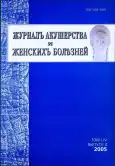Evaluation of a real-time nucleic acid sequencebased amplification (nasba) assay for diagnosis of urogenital chlamydial infection
- Authors: Shipitsyna Е.V.1, Savicheva А.М.1, Vorobyova N.E.2, Sokolovsky Е.V.2, Guschin А.Е.3, Ryzhikh Р.G.3, Shipulin G.A.3, Krotin P.N.4, Merculova L.V.4, Landina О.Y.4
-
Affiliations:
- Research Institute of Obstetrics, Gynecology and Reproductology named after D.O. Ott
- State Medical University named after academician I.P. Pavlova
- FGUN Central Research Institute of Epidemiology, Rospotrebnadzor
- Youth Center "Juventa"
- Issue: Vol 54, No 4 (2005)
- Pages: 17-21
- Section: Original study articles
- URL: https://journal-vniispk.ru/jowd/article/view/83578
- DOI: https://doi.org/10.17816/JOWD83578
- ID: 83578
Cite item
Full Text
Abstract
This study was aimed to evaluate a new realtime nucleic acid sequence-based amplification (NASBA-Real- Time) assay for diagnosis of urogenital Chlamydia trachomatis infection. A total of 193 patients aged 16 to 42 (mean age, 22,8 years) were examined, with most of them having symptoms of urogenital infection. Cervical and urethral swabs from women and men, respectively, were investigated with the use of cell culture method, polymerase chain reaction (PCR) and NASBA- Real-Time. C. trachomatis infection was diagnosed in 29 patients (15 %): in 21 patients - by all the three methods, whereas 8 samples were culture negative. Sensitivity of PCR and NASBA- Real-Time methods were 100 %, cell culture method - 78,4 %. Negative predictive value of PCR and NASBA-Real-Time was found to be 100 %, and that of cell culture - 95,3 %. Specificity as well as positive predictive values of all the three methods equaled 100%. Thus, the new real-time NASBA-Real-Time assay was shown to be a very sensitive and specific test, which can be recommended as a confirmatory method for diagnosis of urogenital chlamydial infection.
Keywords
Full Text
##article.viewOnOriginalSite##About the authors
Е. V. Shipitsyna
Research Institute of Obstetrics, Gynecology and Reproductology named after D.O. Ott
Author for correspondence.
Email: info@eco-vector.com
Russian Federation, Saint Petersburg
А. М. Savicheva
Research Institute of Obstetrics, Gynecology and Reproductology named after D.O. Ott
Email: info@eco-vector.com
Russian Federation, Saint Petersburg
N. E. Vorobyova
State Medical University named after academician I.P. Pavlova
Email: info@eco-vector.com
Russian Federation, Saint Petersburg
Е. V. Sokolovsky
State Medical University named after academician I.P. Pavlova
Email: info@eco-vector.com
Russian Federation, Saint Petersburg
А. Е. Guschin
FGUN Central Research Institute of Epidemiology, Rospotrebnadzor
Email: info@eco-vector.com
Russian Federation, Moscow
Р. G. Ryzhikh
FGUN Central Research Institute of Epidemiology, Rospotrebnadzor
Email: info@eco-vector.com
Russian Federation, Moscow
G. A. Shipulin
FGUN Central Research Institute of Epidemiology, Rospotrebnadzor
Email: info@eco-vector.com
Russian Federation, Moscow
P. N. Krotin
Youth Center "Juventa"
Email: nfo@eco-vector.com
Russian Federation, Saint Petersburg
L. V. Merculova
Youth Center "Juventa"
Email: nfo@eco-vector.com
Russian Federation, Saint Petersburg
О. Y. Landina
Youth Center "Juventa"
Email: nfo@eco-vector.com
Russian Federation, Saint Petersburg
References
Supplementary files






